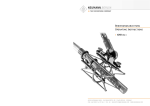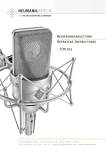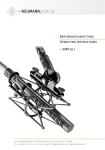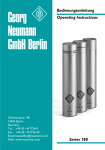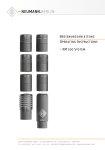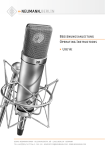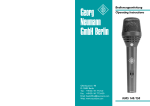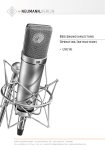Download Neumann.Berlin KMR 82 i User's Manual
Transcript
neumann.berlin the microphone company Bedienungsanleitung Operating Instructions KMR 82 i georg neumann gmbh · ollenhauerstr. 98 · 13403 berlin · germany fon +49 (0)30 / 41 77 24-0 · fax -50 · [email protected] · www.neumann.com KMR 82 i Inhaltsverzeichnis Table of Contents 1 Das Kondensator-Richtrohrmikrophon KMR 82 i 1. The KMR 82 i Condenser Shotgun Microphone 1.1 Ausführungsformen und Beschaltung des Mikrophonausganges 1.1 Microphone Versions and Output Wiring 1.2 Mikrophonkabel 1.2 Microphone Cables 2. Stromversorgung 2. Power Supply 2.1 Phantomspeisung 2.1 Phantom Powering 2.2 Betrieb mit Netzgeräten 2.2 Operation with AC Power Supply 2.3 Batteriespeisung 2.3 Battery Powering 2.4. Betrieb an unsymmetrischen und mittengeerdeten Eingängen 2.4. Operation with Unbalanced or Center Tap Grounded Inputs 3. Technische Daten 3. Technical Specifications 4. Frequenzgänge und Polardiagramm 4. Frequency Responses and Polar Pattern 5. Empfehlungen für den Gebrauch der Windschutzeinrichtungen 5. Recommendation for the Use of Windscreens in Combination 6. Einige Hinweise zur Pflege von Mikrophonen 6. Hints on Microphone Maintenance 7. Zubehör 7. Accessories 1. Das KondensatorRichtrohrmikrophon KMR 82 i 1. The KMR 82 i Condenser Shotgun Microphone Das Richtrohrmikrophon KMR 82 i ist ein Kondensatormikrophon der Serie fet 80®. Es wird vorzugsweise eingesetzt, wenn das Aufnahmemikrophon nicht nahe an der Schallquelle postiert werden kann oder wenn es bei Videoaufnahmen nicht im Bild erscheinen darf. Die Richtcharakteristik des Mikrophons ist keulenförmig. Das Mikrophon KMR 82 i zeichnet sich durch nahezu frequenzunabhängige Dämpfung seitlich einfallenden Schalls, geringstes Eigenrauschen und gutes Impulsverhalten aus. Kleine Abmessungen und geringes Gewicht bei günstig liegendem Schwerpunkt ermöglichen ermüdungsfreie Handhabung und problemlose Schwenks ohne Nachwippen des Mikrophons. Aus der Forderung nach möglichst gleichmäßiger Dämpfung bei allen Frequenzen des Übertragungsbereichs ergibt sich eine vergleichsweise geringe Länge des verwendeten Richtrohres. Für Frequenzen, deren Wellenlänge größer als die Rohrlänge ist, arbeitet das Mikrophon als Druckgradientenempfänger, während es oberhalb 1,5 kHz für seitlich einfallenden Schall als Inter- 2 The KMR 82 i shotgun microphone is a fet 80® series condenser microphone. lt is particularly recommended for use under recording conditions where a conventional microphone cannot be positioned within the desired distance of the sound source or, for video, when the microphone should not appear in the picture. The directional characteristic of the KMR 82 i is lobe shaped. The KMR 82 i microphone is characterized by its largely frequency-independent rejection of sound impinging at any angle off the microphone’s maximum sensitivity axis, by its very low self-noise and its good transient behavior. Its small dimensions and lightweight construction with a convenient centre of gravity, make for ease of handling and unproblematic panning without any whiplash effect. Since it is desirable that all frequencies be attenuated to the same extent, the interference tube may be kept relatively short. At frequencies whose wavelength is longer than the tube length, the microphone works as a pressure gradient transducer, whereas for laterally-incident sound ferenzempfänger wirkt. Schallereignisse außerhalb der „Blickrichtung“ des Mikrophons werden zwar leiser, aber nicht klangverfärbt aufgenommen. Das Mikrophon kann daher auch zur gezielten Aufnahme einzelner Instrumente im Orchester eingesetzt werden. Auch die Überlappung der Aufnahmebereiche mehrerer Richtrohre ist problemlos möglich. Das KMR 82 i ist sehr hoch aussteuerbar und besitzt eine bemerkenswert niedrige Ersatzlautstärke. Der Strombedarf von 0,7 mA, das geringe Gewicht von 250 g und die Unempfindlichkeit gegenüber Wind- und Griffgeräuschen machen das Mikrophon auch für den Reportagebetrieb besonders geeignet. Bei Außenaufnahmen ist dennoch ein zusätzlicher Schutz gegen Windeinflüsse empfehlenswert. Der Windschirm WS 82 aus Polyurethanschaum gehört zum Lieferumfang und sorgt auch während des Transportes für weiche Lagerung des Mikrophons in seinem Lederköcher. above 1.5 kHz, it operates according to the phasecancellation principle. As a result, sound from off the microphone’s maximum sensitivity axis is picked up with reduced intensity, but without sound coloration. The KMR 82 i may therefore also be used to record individual instruments of an orchestra. The overlapping of the pick-up areas of several interference tubes likewise presents no problem. The KMR 82 i is virtually overload-proof and has a remarkably low self-noise level. Its 0.7 mA current consumption, its 250 g light weight and its insensitivity to wind and finger noise make it also ideally suited for location reporting. However, for outdoor use an additional wind protection is recommended. For this purpose a WS 82 expanded polyurethane windscreen is included. The windscreen doubles as soft padding when the microphone is in its leather carrying case. Als weitere Maßnahme gegen Störschall beschneidet im KMR 82 i ein elektrischer Hochpass unterhörfrequenten Schall. Seine Grenzfrequenz lässt sich mit einem versenkt angebrachten Schiebeschalter auf 120 Hz (–3 dB) erhöhen. As a further measure, an electrical high-pass filter cuts off subaudible frequencies. Its turn-over frequency may be raised to 120 Hz (–3 dB) by means of a flush-mounted slide switch. Im Frequenzbereich von 2 kHz bis 15 kHz besitzt das Übertragungsmaß des KMR 82 i eine Anhebung zum Ausgleich von Übertragungsverlusten in Luft bei großen Entfernungen des Mikrophons zur Schallquelle. The KMR 82 i now shows a boost in the frequency range between 2 kHz and 15 kHz, to compensate for air friction losses for larger sound source to microphone distances. Bei Nahaufnahmen können dadurch insbesondere Zischlaute überbetont werden. Deshalb erlaubt ein zweiter Schiebeschalter, das Übertragungsmaß für hohe Frequenzen relativ abzusenken (10 kHz – 4 dB) und damit zu linearisieren (s. Seite 12). This may produce over accentuation of sibilant sounds for close microphone placement. A second slide switch has therefore been added to lower those higher frequencies (10 kHz – 4 dB), thereby linearizing the response. 1.1 Ausführungsformen und Beschaltung des Mikrophonausganges 1.1 Microphone Versions and Output Wiring Das Mikrophon kann in folgenden Ausführungsformen geliefert werden: The following versions of the KMR 81 i microphone are available: KMR 82 i ............ ni ............. Best.-Nr. 06878 Ausführung mit 3-poligem Switchcraft-Steckereinsatz und nickelmatter Oberfläche. Erforderliches Gegenstück: XLR 3 F. KMR 82 i ............ ni ............... Cat. No. 06878 Version with male 3-pin connector insert and satin nickel finish. Requires XLR 3 F female connector. KMR 82 i mt ....... sw ............ Best.-Nr. 06879 wie oben, jedoch mit schwarzmatter Oberfläche. KMR 82 i mt ....... blk ............. Cat. No. 06879 as above, but with matte black finish. Die Zuordnung der Mikrophonanschlüsse entspricht DIN EN 60268-12 bzw. IEC 60268-12: The microphone is wired as per DIN EN 60268-12 or IEC 60268-12. 3 KMR 82 i Die Modulationsadern liegen an Pin 2 und 3, die Abschirmung an Pin 1. Bei einem Schalldruckanstieg vor der Mikrophonmembran tritt an Pin 2 eine positive Spannung auf. The modulation is connected to pins 2 and 3; the shield is connected to pin 1. A sudden increase in sound pressure in front of the microphone diaphragm causes a positive voltage to appear at pin 2. Der 3-polige XLR-Steckverbinder hat folgende Belegung: The 3-pin XLR connector has the following pin assignments: Pin 1: 0 V/Masse Pin 2: Modulation (+Phase) Pin 3: Modulation (–Phase). Pin 1: 0 V/ground Pin 2: Modulation (+phase), Pin 3: Modulation (–phase). Auf die Anschlussdosen können wahlweise auch dynamische Mikrophone oder Bändchenmikrophone sowie die Modulationskabel röhrenbestückter Kondensatormikrophone geschaltet werden, ohne dass die Speisegleichspannung abgeschaltet werden muss. Der Ausgang eines Neumann-Phantomspeisegerätes darf auch auf bereits anderweitig phantomgespeiste Mikrophoneingänge gesteckt werden. 2.2 Betrieb mit Netzgeräten 1.2 Mikrophonkabel 2. Für das KMR 81 i stehen folgende Kabel zur Verfügung: The following cables are available for the KMR 81 i microphone: IC 3 mt ............... sw ............ Best.-Nr. 06543 Mikrophonkabel mit Doppeldrallumspinnung als Abschirmung. Ø 5 mm, Länge 10 m. XLR 3 Steckverbinder, schwarzmatt. IC 3 mt ................ blk ............. Cat. No. 06543 Microphone cable with double twist (double helix) braiding as shield. Ø 5 mm, length 10 m. XLR 3 connectors, matte black. IC 31 mt (5 m) ... sw ............ Best.-Nr. 06570 Mikrophonkabel mit Doppeldrallumspinnung als Abschirmung. Textilumsponnen, zur Vermeidung von Reibgeräuschen bei der Verwendung an Mikrophonangel oder Windschutzkorb. Ø 4,5 mm, Länge 5 m. XLR 3 Steckverbinder, schwarzmatt. IC 31 mt (5 m) .... blk ............. Cat. No. 06570 Microphone cable with double twist (double helix) braiding as shield. Textile-braided to avoid frictional noise due to the handling of booms or plastic leadings (for example in windscreens). Ø 4,5 mm, length 5 m. XLR 3 connectors, matte black. AC 25 (0,3 m) ...................... Best.-Nr. 06600 Adapterkabel mit XLR 3 F-Buchse und 6,3 mm Monoklinkenstecker, unsymmetrisch, für den Anschluss des 3-poligen XLR-Ausganges eines Speisegerätes an Geräte mit 6,3 mm Monoklinkenbuchse. Für alle Mikrophone mit Ausnahme der Ausgangsstufe KM 100 und des GFM 132. AC 25 (0.3 m) ......................... Cat. No. 06600 Adapter cable with XLR 3 M connector and unbalanced 6.3 mm mono jack. It is used to connect 3pin XLR outputs of power supplies to units with a 6.3 mm monojack input. Designed for all microphones, excluding KM 100 System and GFM 132. Andere Kabellängen sind auf Wunsch lieferbar. Special cable lengths can be made to order. Stromversorgung 2.1 Phantomspeisung Das KMR 82 i wird mit 48 V phantomgespeist (P48, IEC 61938). Bei der Phantomspeisung fließt der Speisestrom vom positiven Pol der Spannungsquelle über die elektrische Mitte der beiden Modulationsadern zum Mikrophon. Er wird hierzu über zwei gleichgroße Widerstände beiden Tonadern gleichsinnig zugeführt. Die Rückleitung des Gleichstroms erfolgt über den Kabelschirm. Zwischen beiden Modulationsadern besteht also keine Potentialdifferenz. Daher ist mit der Phantomspeisung eine kompatible Anschlusstechnik möglich: 4 1.2 Microphone Cables 2. Power Supply 2.1 Phantom Powering The KMR 82 i is phantom powered at 48 V (P48, IEC 61938). With phantom powering the dc from the positive supply terminal is divided via two identical resistors, one half of the dc flowing through each audio (modulation) conductor to the microphone, and returning to the voltage source via the cable shield. Phantom powering provides a fully compatible connecting system, since no potential differences exist between the two audio conductors. Für die Stromversorgung sind alle P48-Netzgeräte geeignet, die mindestens 1 mA je Kanal abgeben. Das Neumann P48-Netzgerät hat die Bezeichnung N 248. Es ist zur Stromversorgung zweier MonoKondensatormikrophone oder eines Stereomikrophons mit 48 V ± 1 V, maximal 2 x 6 mA, geeignet (siehe auch Neumann-Druckschrift 68832: „48 VPhantomspeisegeräte“). Die Zuordnung der Mikrophonanschlüsse und die Polarität der Modulationsadern ist am Ausgang des Speisegerätes die gleiche wie am Mikrophon. Das Netzgerät N 248 versorgt ein oder zwei Mikrophone mit 48 V-Phantomspeisung P48. Alle Anschlüsse mit XLR 3-Flanschdosen. Die Modulationsausgänge sind gleichspannungsfrei. Studio outlets so powered will therefore also accept dynamic microphones and ribbon microphones as well as the modulation conductors of tube-equipped condenser microphones without the need to switch off the dc supply voltage. No harm is done even if a Neumann phantom power supply is connected to the inputs of microphones which are phantom powered from another source. 2.2 ac Supply Operation All P48 power supplies in accordance with IEC 61938 which provide at least 1 mA per channel, are suitable for powering the microphones. The Neumann P48 power supply unit bears the designation N 248. It is designed to power two mono condenser microphones or one stereo microphone at 48 V ± 1 V, max. 2 x 6 mA (see also Neumann bulletin no. 68832: “Phantom 48 VDC Power Supplies”). The assignment of the microphone terminals and the modulation polarity at the power supply output are identical to those at the microphone. The N 248 supplies one stereo microphone, or two mono condenser microphones with 48 V phantom power (P48). All connectors are of XLR 3 type. The audio signal outputs are DC-free. Das Gerät ist in drei Ausführungen erhältlich: Three versions are available: N 248 EU ............ sw ............ Best.-Nr. 08537 N 248 US ............ sw ............ Best.-Nr. 08538 N 248 UK ............ sw ............ Best.-Nr. 08539 N 248 EU ............ blk ............. Cat. No. 08537 N 248 US ............ blk ............. Cat. No. 08538 N 248 UK ............ blk ............. Cat. No. 08539 2.3 Batteriespeisung 2.3 Battery Powering Steht keine Netzspannung zur Verfügung, kann die Speisung mit einem der Geräte If a mains power source is not available, power can be supplied by one of the battery units BS 48 i .................................. Best.-Nr. 06494 (für ein Mikrophon) BS 48 i .................................... Cat. No. 06494 (for one microphone) BS 48 i-2 ............................... Best.-Nr. 06496 (für zwei Mikrophone) erfolgen. Beide Geräte liefern 48 V ± 1 V, maximal je 5 mA, und werden jeweils von einer 9 VoltBlockbatterie Typ IEC 6 F 22 gespeist. BS 48 i-2 ................................. Cat. No. 06496 (for two microphones) Both units deliver 48 V ± 1 V, at 5 mA maximum, and are powered by a 9-volt monobloc battery Type IEC 6 F 22. Das Gerät BS 48 i-2 ist mit 5-poligen, das BS 48 i mit 3-poligen XLR-Steckverbindern ausgerüstet. The BS 48 i-2 is equipped with 5-pin XLR connectors, the BS 48 i with 3-pin XLR connectors. (Siehe auch Neumann-Druckschrift 68832... „48 VPhantomspeisegeräte“). (See Neumann bulletin 68832... “Phantom 48 VDC Power Supplies”.) 5 KMR 82 i Die Zuordnung der Mikrophonanschlüsse und die Polarität der Modulationsadern ist am Ausgang der Speisegeräte die gleiche wie am Mikrophon. 2.4 Betrieb an unsymmetrischen oder mittengeerdeten Eingängen The assignment of the microphone terminals and the modulation polarity at the power supply output are identical to those at the microphone. 2.4 Operation with Unbalanced or Center Tap Grounded lnputs Die 48 V-Phantom-Speisegeräte BS 48 i, BS 48 i-2 und N 248 haben gleichspannungsfreie Ausgänge, so dass für den Anschluss an unsymmetrische Eingänge kein Übertrager erforderlich ist. The BS 48 i, BS 48 i-2 and N 248 phantom 48 Vdc power supplies are dc-free so that no transformer is required for connection to unbalanced inputs. Beim KMR 82 i ist Pin 2 normgemäß die „heiße Phase“. Für unsymmetrische Eingänge muss PIN 3 am Ausgang des Speisegerätes an Masse gelegt werden (siehe Abbildung 1). In the case of the KMR 82 i condenser microphone pin 2 is the “hot phase”, in accordance with the standard, and pin 3 of the output of the power supply must be connected to earth (see Fig. 1). 3. Technische Daten Technical Specifications Akustische Arbeitsweise ........... Druckgradienteninterferenzempfänger Acoustical op. principle ............. Pressure gradient interference transducer Richtcharakteristik ................... Superniere/Keule Directional pattern ..... Supercardioid/Lobe shaped (Shotgun) Übertragungsbereich .................... 20 Hz...20 kHz Frequency range .......................... 20 Hz...20 kHz Feldübertragungsfaktor1) ................................... 21 mV/Pa ± 1 dB Sensitivity Nennimpedanz ..................................... 150 Ohm Rated impedance ................................. 150 ohms 1) ............................ 21 mV/Pa ± 1 dB Nennlastimpedanz .............................. 1000 Ohm Rated load impedance ....................... 1000 ohms Bei vielen anderen als den o.g. PhantomspeisegeIn the case of many other phantom powering units räten liegen nicht nur die Modulationsleitungen (except those mentioned above), not only the modzum Mikrophon auf dem Potential der Speisespanulation leads to the microphone, but also the outnung von +48 V, sondern auch die vom Speisegegoing modulation leads from the powering unit, rät abgehenden Modulationsleitungen. Für die in are at the potential of the feed voltage (+48 V). der Studiotechnik allgemein üblichen symmetriThis is of no significance for the balanced, floatschen und erdfreien Vering amplifier and mixing stärker und Mischpulteinconsole inputs in general gänge ist dies ohne Bestudio use. On the other deutung. Dagegen wird hand, the feed voltage die Speisespannung beim will be short-circuited Anschluss an einseitig when connected to sinoder mittengeerdete Vergle-ended or center tap stärkereingänge kurzgegrounded amplifier inschlossen, und es ist kein puts, and no operation Betrieb möglich. Dann bewill be possible. This can Abbildung / Figure 1 stehen folgende Löbe circumvented as folsungsmöglichkeiten: lows: Geräuschpegelabstand2), CCIR3) ....................................................... 71 dB Signal-to-noise ratio2), CCIR3) ....................................................... 71 dB Geräuschpegelabstand2), A-bewertet3) ............................................. 82 dB Signal-to-noise ratio2), A-weighted3) ............................................. 82 dB Ersatzgeräuschpegel, CCIR3) ....................................................... 23 dB Equivalent noise level, CCIR3) ...................................................... 23 dB Ersatzgeräuschpegel, A-bewertet3) .......................................... 12 dB-A Equivalent noise level, A-weighted3) .......................................... 12 dB-A Grenzschalldruckpegel für 0,5 % Klirrfaktor4) .................................. 128 dB Maximum SPL for 0.5 % THD4) ...................................... 128 dB Max. Ausgangsspannung ......................... 2,6 dBu Max. output voltage ................................ 2.6 dBu Speisespannung5) .............................. 48 V ± 4 V Supply voltage5) ................................ 48 V ± 4 V Stromaufnahme5) ..................................... 0,7 mA Current consumption5) .............................. 0.7 mA a) In mittengeerdeten Geräten mit Eingangsübertrager (z.B. einige NAGRA-Geräte) kann die betreffende Erdverbindung fast immer ohne Nachteile für die Funktion des Gerätes aufgetrennt werden. Erforderlicher Steckverbinder .................. XLR 3 F Matching Connector ................................. XLR 3 F Gewicht .................................................... 250 g Weight ...................................................... 250 g Durchmesser ............................................ 21 mm Diameter ................................................. 21 mm Länge ................................................... 395 mm Length .................................................. 395 mm 94 dB SPL 1 Pa = 10 µbar 0 dB 20 µPa 94 dB SPL 1 Pa = 10 µbar 0 dB 20 µPa 1) bei 1 kHz an 1 kOhm Nennlastimpedanz. 1) at 1 kHz into 1 kohms rated load impedance. 2) bezogen auf 94 dB SPL 2) re 94 dB SPL 3) nach IEC 60268-1; CCIR-Bewertung nach CCIR 468-3, Quasi-Spitzenwert; A-Bewertung nach IEC 61672-1, Effektivwert 3) according to IEC 60268-1; CCIR-weighting acccording to CCIR 468-3, quasi peak; A-weighting according to IEC 61672-1, RMS 4) Klirrfaktor des Mikrophonverstärkers bei einer Eingangsspannung, die der von der Kapsel beim entsprechenden Schalldruck abgegebenen Spannung entspricht. 4) THD of microphone amplifier at an input voltage equivalent to the capsule output at the specified SPL. 5) Phantom powering (P48, IEC 1938). b) In jede abgehende Modulationsleitung kann zur Abblockung der 48 VGleichspannung eine RCKombination eingefügt werden (siehe Abbildung 2 und Neumann-Information Nr. 84 221). a) In center tap grounded equipment with input transformer (e.g. some NAGRA units), the earth lead can almost always be disconnected without affecting the function of the equipment. b) In every outgoing modulation lead, an RC network can be incorporated to block the 48 Vdc voltage (See Figure 2 and Neumann-Information no. 84 222). Abbildung / Figure 2 5) 6 3. Phantomspeisung (P48, IEC 1938). 7 KMR 82 i 4. Frequenzgänge und Polardiagramm Frequency Responses and Polar Pattern gemessen im freien Schallfeld nach IEC 60268-4, Toleranz ±2 dB measured in free-field conditions (IEC 60268-4), tolerance ±2 dB 5. Empfehlung für den Gebrauch der Windschutzeinrichtungen 5. Recommendation for the Use of Windscreens in Combination Zur Vermeidung von Störgeräuschen, die bei Nahbesprechung, Windeinfluss oder beispielsweise bei schnellem Schwenken des Mikrophons auftreten können, sind verschiedene Windschutzeinrichtungen lieferbar (siehe auch Kapitel 7. Zubehör). Different kinds of windscreens are available to avoid problems caused by wind, close talking, and rapid movements of the microphone (refer to chapter 7. Accessories). Mit dem Einsatz von Windschutzeinrichtungen ist immer eine, wenn auch meist geringe, Bedämpfung hoher Frequenzen verbunden. Dieser Effekt verstärkt sich allerdings, wenn zur Erhöhung der Wirksamkeit mehrere Windschutzeinrichtungen miteinander kombiniert werden. Deshalb ist auf jeden Fall eine Betrachtung der Effektivität solcher Kombinationen angezeigt. The application of windscreens causes always some attenuation of high frequencies, although mostly minor. This loss is more noticeable when a combination of more than one screen is used in order to increase the amount of protection. lt is therefore necessary to consider the actual combined effect of such an arrangement. Windschutzeinrichtungen sind um so wirksamer, je mehr freie Wegstrecke (in gewissen Grenzen) zwischen ihnen und dem Mikrophon verbleibt. Within a certain range the protection of any windscreen increases proportionately with the empty space between the screen itself and the microphone. For example, using the WK 82 windscreen the inner space should be clear of anything except the microphone (and mounting hardware). The additional application of the WS 82 foam windshield would not only decrease efficiency of the protection but would also reduce high frequencies unnecessarily. Bei Verwendung des Windschutzkorbes WK 82, beispielsweise, sollte der Raum bis zum Mikrophon wirklich frei sein! Eine zusätzliche Verwendung des Windschutzes WS 82 würde nicht nur den Windschutzeffekt herabsetzen, sie würde darüber hinaus die hohen Frequenzen unnötigerweise stark bedämpfen. Die abgebildeten Kombinationen stellen zwei wirkungsvolle Varianten für jeweils unterschiedlich starken Windeinfall bei gleichzeitiger geringstmöglicher Frequenzbeeinträchtigung dar. The following illustrations show two successful methods of using various windscreen combinations to adjust to different wind disturbances while offering a minimum reduction in high frequency response. Einfluß der Windschutzeinrichtungen auf den Frequenzgang Influence of Windscreening to the Frequency Response WS 82 8 KMR 82 i 9 KMR 82 i 6. a b a = KMR 82 i b = KMR 82 i + WS 82 WJ 82 WK 82 HG 82 oder/or SG 82 b c 10 b = KMR 82 i + WK 82 c = KMR 82 i + WK 82 + WJ 82 6. Hints on Microphone Maintenance Staubschutz verwenden: Mikrophone, die nicht im Einsatz sind, sollte man nicht auf dem Stativ einstauben lassen. Mit einem Staubschutzbeutel (nicht fusselnd) wird dies verhindert. Wird ein Mikrophon längere Zeit nicht verwendet, sollte es staubgeschützt bei normalem Umgebungsklima aufbewahrt werden. Use a dust cover: Microphones not in use should not be left on the stand gathering dust. This can be prevented by the use of a non-fluffy dust cover. When not in use for a longer period, the microphone should be sealed against dust and stored under standard climatic conditions. Popschutz verwenden: Ein Popschutz hat nicht nur die Aufgabe, bei Gesangsaufnahmen die Entstehung von Poplauten zu verhindern. Er vermeidet auch effizient, dass sich von der Feuchtigkeit des Atems bis hin zu Essensresten unerwünschte Partikel auf der Membran ablagern. Use a pop screen: A pop screen not only prevents the occurrence of plosive pop noises in vocal recordings, but also efficiently prevents unwanted particles, from respiratory moisture to food remnants, from settling on the diaphragm. Keine überalterten Windschutze verwenden: Auch Schaumstoff altert. Das Material kann brüchig und krümelig werden. Anstatt das Mikrophon zu schützen, kann er dann zur Verunreinigung der Mikrophonkapsel führen. Überalterte Windschutze also bitte entsorgen. Avoid the use of old wind shields: As the foam material of a wind shield ages it can become brittle and crumbly. Instead of protecting the microphone, an old wind shield can thus lead to soiling of the microphone capsule. Therefore please dispose of worn-out wind shields. Funktionstest: Moderne Kondensatormikrophone nehmen durch lautes Ansprechen keinen Schaden. Zur Kontrolle, ob ein solches Mikrophon angeschlossen ist, sollte man es aber keinesfalls anpusten oder anpoppen, da dies einem akustischen Signal von mehr als 140 dB (!) entsprechen kann. Normale Sprache genügt zum Funktionstest völlig. Function testing: Although modern condenser microphones are not harmed by high sound pressure levels, one should under no circumstances use a pop-test to check whether the microphone is connected and the channel on the mixing console is pulled up, since this can result in sound pressure levels of over 140 dB! Normal speech is quite sufficient for function testing. Selbsthilfe kann teuer sein! Leider kommt es doch vor, dass durch eine Selbstreparatur mehr beschädigt als behoben wird. Insbesondere das Reinigen verschmutzter Kapseln erfordert viel Erfahrung und die Hand eines Fachmanns. Der Lackschutz auf Platinen zeigt u.a. an, dass dort nicht gelötet werden darf. Einige Bauteile sind speziell selektiert und können nicht durch Material von der Stange ersetzt werden. Um unnötige Kosten zu vermeiden, empfiehlt sich die Einsendung an unsere Vertretungen oder an uns. EA 82 oder/or H 82 a a = KMR 82 i Einige Hinweise zur Pflege von Mikrophonen Inspektion durchführen lassen: Regelmäßiges Durchchecken des Mikrophonbestands, wie es einige Schauspielhäuser und Rundfunkanstalten praktizieren, kann bei der Früherkennung von Schäden helfen. Leichte Verschmutzungen lassen sich eher beseitigen, als eine untrennbar in die Membran eingebrannte Nikotinschicht. Insbesondere bei Mikrophonen im Verleih und in verunreinigenden Umgebungen empfiehlt sich die regelmäßige Kontrolle, deren Kosten im Vergleich zu einer aufwendigen Reparatur sehr gering sind. Do-it-yourself repairs can be expensive! Unfortunately, do-it-yourself repairs sometimes do more harm than good. Cleaning soiled capsules in particular requires considerable experience and an expert touch. The protective lacquer on circuit boards indicates, among other things, places which must not be soldered. Certain components are specially selected and cannot be replaced by standard parts. To avoid unnecessary expense, we recommend sending defective microphones to us or our representatives for servicing. Regular inspections: Sending in microphones regularly for inspection, as practiced by some theaters and broadcasting corporations, can aid in the early detection of damage. Slight soiling can be removed much more easily than a nicotine layer inextricably bonded to the diaphragm. Regular inspections are particularly to be recommended for microphones which are rented or are used in dusty or smoky environments, since the costs are low in comparison with the cost of a major overhaul. 11 KMR 82 i 7. 12 Zubehör*) Accessories*) Schwanenhälse Goosenecks Elastische Aufhängungen Elastic Suspensions EA 82 .................. ni ............. Best.-Nr. 06846 EA 82 mt ............ sw ............ Best.-Nr. 06848 Die EA 82 ist für die Richtrohrmikrophone KMR 81 i/KMR 82 i vorgesehen. Sie kann am Stativgelenk SG 82 oder am Handgriff HG 82 befestigt werden und dient auch zur Montage der Mikrophone in einem Windschutzkorb WK 81/WK 82. EA 82 .................. ni ............... Cat. No. 06846 EA 82 mt ............ blk ............. Cat. No. 06848 The EA 82 is designed for the KMR 81 i and KMR 82 i shotgun microphones. It can be attached to the SG 82 swivel mount or the HG 82 handle and is also used for the installation of the microphones in the WK 81 or WK 82 windscreen. SMK 8 i ............... sw ............ Best.-Nr. 06181 Der Schwanenhals SMK 8 i hat eine Länge von 360 mm und dient zum elektrischen und mechanischen Anschluss eines Mikrophons mit XLR 3 MStecker. Eine Kontermutter arretiert das Mikrophon klapperfrei und bietet einen gewissen Diebstahlschutz. Der Kabelaustritt ist seitlich über dem Gewindeanschluss. Kabellänge 4,5 m, Kabelstecker XLR 3 M. Gewindeanschluss: 5/8"-27-Gang, mit Adapter für 1/2"- oder 3/8"-Stative. SMK 8 i ............... blk ............. Cat. No. 06181 The SMK 8 i gooseneck is 360 mm long and serves as electrical and mechanical connection of a microphone with XLR 3 connector. A counter nut secures the microphone against rattle and – to a certain extent – against theft. The cable comes out at the side, just above the bottom thread. Cable length 4.5 m, cable connector XLR 3 M. The gooseneck has a 5/8"-27 female thread, plus a thread adapter to connect to 1/2" and 3/8" stands. Mikrophonneigevorrichtungen Auditorium Hangers MNV 21 mt .......... sw ............ Best.-Nr. 06802 Die Neigevorrichtung ermöglicht die Einstellung der Mikrophonneigung bei frei am Kabel hängendem Mikrophon. Die MNV 21 mt besteht aus einer schwenkbaren Klammer zur Aufnahme eines Kleinmikrophons oder KMR 81 und aus einer Kabelführung mit Drehverschluss. MNV 21 mt .......... blk ............. Cat. No. 06802 The auditorium hanger adjusts the tilting angle of a microphone suspended by its own cable. The MNV 21 consists of the tilting clamp, suitable to hold a Neumann miniature microphone or KMR 81, and a locking cable strain relief. Tisch- und Fußbodenständer Table and Floor Stands MF 3 ................... blk ............. Cat. No. 07321 The MF 3 is a table stand with iron base, 1.6 kg in weight, 110 mm in diameter. It has a black matte finish. The bottom is fitted with a non-slip rubber disk. The stand comes with a reversible stud and an adapter for 1/2" and 3/8" threads. Stativgelenke und mechanische Adapter Stand Mounts and Mechanical Adapters MF 3 ................... sw ............ Best.-Nr. 07321 Der Mikrophonfuß MF 3 ist ein Tischständer mit Eisenfuß, 1,6 kg schwer, Durchmesser 110 mm. Der Ständer ist schwarzmatt lackiert und steht gleitfest auf einer Moosgummischeibe. Ein umwendbarer Gewindezapfen und ein mitgeliefertes Reduzierstück ermöglichen die Verwendung für 1/2"und 3/8"-Gewindeanschlüsse. H 82 ................... sw ............ Best.-Nr. 07190 Halteschiene zur starren Befestigung eines Mikrophons mit Durchmessern von 21 bis 22 mm. Die Halteschiene selbst wird auf dem Stativgelenk SG 82 und dem Handgriff HG 82 befestigt. H 82 ................... blk ............. Cat. No. 07190 Mounting bracket for secure fixed positioning of microphones with a diameter of 21 or 22 mm. The mounting bracket itself can be attached to the SG 82 swivel mount and the HG 82 handle. MF 4 ................... blk ............. Cat. No. 07337 Floor stand with grey cast iron base. The floor stand has a matt black finish and rests on a nonskid rubber disk attached to the bottom. A reversible stud and a reducer for 1/2" and 3/8" threads are also supplied. Weight 2.6 kg, Ø 160 mm. HG 82 ................. sw ............ Best.-Nr. 06856 Handgriff für in der Hand zu haltende Mikrophone. Eine schwenkbare Aufnahme ermöglicht die Befestigung der Halteschiene H 82 oder der elastischen Aufhängung EA 82/EA 30 B, auch mit Windschutzkorb. Der Handgriff hat ein 3/8"- Gewinde zur Stativbefestigung. HG 82 ................. blk ............. Cat. No. 06856 Handle for work with hand-held microphones. An adjustable bracket allows to attach the H 82 mounting bracket or the EA 82/EA 30 B elastic suspension, with or without windscreen. The handle has a 3/8" thread to connect ot stands. MF 4 ................... sw ............ Best.-Nr. 07337 Der Mikrophonfuß MF 4 ist ein Fußbodenständer aus Grauguss, ca. 2,6 kg schwer, Ø 160 mm. Der Ständer ist schwarzmatt lackiert und steht gleitfest auf einem Gummiring. Ein umwendbarer Gewindezapfen und ein mitgeliefertes Reduzierstück ermöglichen die Verwendung für 1/2"- und 3/8"Gewindeanschlüsse. MF 5 ................... ni ............... Cat. No. 08489 Floor stand with grey soft-touch powder coating. It has a non-skid sound-absorbing rubber disk attached to the bottom. The stand connection has a 3/8" thread. Weight 2.7 kg, Ø 250 mm. SG 21/17 mt ....... sw ............ Best.-Nr. 06149 Das Stativgelenk SG 21/17 mt besitzt eine Kunststoffklammer zur Aufnahme von Kleinmikrophonen. Es hat einen Gewindeanschluss 5/8"-27Gang, mit Adapter für 1/2"- und 3/8"-Stative. Eine weitere Klammer mit 17 mm Durchmesser wird mitgeliefert. Damit kann das Mikrophon am Steckverbinder gehalten werden. SG 21/17 mt ....... blk ............. Cat. No. 06149 Swivel mount with a plastic clamp for miniature microphones. It has a 5/8"-27 female thread, plus a thread adapter to connect to 1/2"- and 3/8" stands. An additional clamp, Ø 17 mm, is included for use when the microphone should be held more elegantly at the XLR connector. MF 5 ................... ni ............. Best.-Nr. 08489 Der Mikrophonfuß MF 5 hat eine graue Soft-Touch Pulverbeschichtung und steht gleitfest und trittschalldämmend auf einem Gummiring. Der Stativanschluss hat ein 3/8"-Gewinde. Gewicht 2,7 kg, Ø 250 mm. STV 4 .................. sw ............ Best.-Nr. 06190 STV 20 ............... sw ............ Best.-Nr. 06187 STV 40 ............... sw ............ Best.-Nr. 06188 STV 60 ............... sw ............ Best.-Nr. 06189 Die Stativverlängerungen STV ... werden zwischen Mikrophonständer (z.B. MF 4, MF 5) und Stativgelenk (z.B. SG 21/17 mt) geschraubt. STV 4 .................. blk ............. Cat. No. 06190 STV 20 ............... blk ............. Cat. No. 06187 STV 40 ............... blk ............. Cat. No. 06188 STV 60 ............... blk ............. Cat. No. 06189 The STV... stand extensions are screwed between microphone stands (for example MF 4, MF 5) and swivel mounts (for example SG 21/17 mt). SG 82 .................. sw ............ Best.-Nr. 06616 Die Elastischen Aufhängungen EA 82/EA 30 B und die Halteschiene H 82 können unter Verwendung des Stativgelenks SG 82 auf Stativen befestigt werden, der Gewindeanschluss hat 5/8"-27-Gang, mit Adapter für 1/2"- und 3/8"-Stative. SG 82 .................. blk ............. Cat. No. 06616 The EA 82/EA 30 B elastic suspensions and the H 82 holder can be fastened to tripods with the help of the SG 82 tripod mount. It has a 5/8"-27 female thread, plus a thread adapter to connect to 1/2"- and 3/8" stands. Die STV ... haben eine Länge von 40, 200, 400 oder 600 mm. Ø 19 mm. Length 40, 200, 400 or 600 mm. Ø 19 mm. 7. 13 KMR 82 i 14 Windschutz Windscreens Bei Außenaufnahmen ist ein zusätzlicher Schutz gegen Windeinflüsse empfehlenswert. Folgende Windschutzeinrichtungen stehen zur Verfügung: For outside recordings, some additional protection against wind noise is recommended. The following wind screening accessories can be supplied: WK 82 ................. gr ............. Best.-Nr. 06855 Windschutzkorb für das KMR 82. Das Mikrophon wird mit der elastischen Aufhängung EA 82 (RSM 191: EA 30 B) befestigt, in den WK eingebracht und mit dem Stativgelenk SG 82 oder Handgriff HG 82 zusammengeschraubt. Eine Windschutzhülle (Textil) wird mitgeliefert. WK 82 ................. gr ............... Cat. No. 06855 Windscreen for KMR 82 microphone. The microphone is mounted in the EA 82 elastic suspension (RSM 191: EA 30 B) and placed inside the windscreen, then attached to the SG 82 swivel mount, or the HG 82 handle. A windscreen cover is included. Dämpfung des Windgeräusches ca. 24 (25) dB. Dämpfung bei 15 kHz ca. 2 (3) dB. Ø 100 mm, Länge 440 (610) mm. Wind noise attenuation 24 (25) dB. Attenuation at 15 kHz 2 (3) dB. Ø 100 mm, length 440 (610) mm. WJ 82 .................. gr ............. Best.-Nr. 07284 Dämpfung des Windgeräusches ca. 8 dB. Dämpfung bei 15 kHz ca. 6 dB. WJ 82 .................. gr ............... Cat. No. 07284 Suppression of wind noise approximately 8 dB. Attenuation at 15 kHz approximately 6 dB. WS 82 ................. sw ............ Best.-Nr. 07264 WS 82 ................. blk ............. Cat. No. 07264 (gehört zum Lieferumfang) Windschutz für KMR 82 i. Dämpfung des Windgeräusches 15 dB. Dämpfung bei 15 kHz 2 dB. Ø 50 mm, Länge 350 mm. Farbe schwarz. (included in the supply schedule) Windscreen for KMR 82 i. Wind noise attenuation 15 dB. Attenuation at 15 kHz 2 dB. Ø 50 mm, length 350 mm. Color black. *) *) Weitere Artikel sind im Katalog „Zubehör“ beschrieben. IC 3 mt IC 31 mt AC 25 N 248 BS 48 i BS 48 i-2 EA 82 (mt) MNV 21 mt H 82 HG 82 SG 21/17 mt SG 82 Further articles are described in the catalog “Accessories”. 15 SMK 8 i STV... Konformitätserklärung Die Georg Neumann GmbH erklärt, dass dieses Gerät die anwendbaren CE-Normen und -Vorschriften erfüllt. MF 3 MF 4 MF 5 WK 82 WJ 82 WS 82 Declaration of Conformity Georg Neumann GmbH hereby declares that this device conforms to the applicable CE standards and regulations. Irrtümer und technische Änderungen vorbehalten • Errors excepted, subject to changes Printed in Germany • Publ. 04/06 068969/A01
This document in other languages
- Deutsch: Neumann.Berlin KMR 82 i









